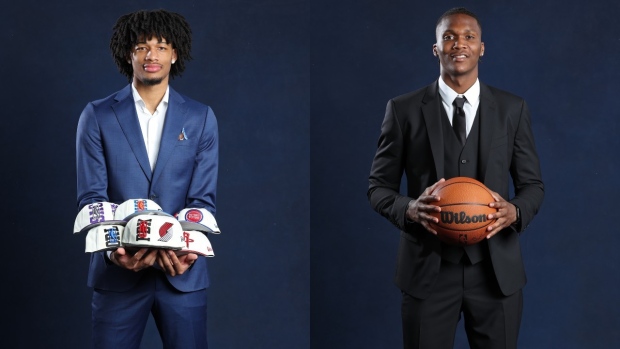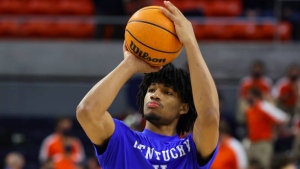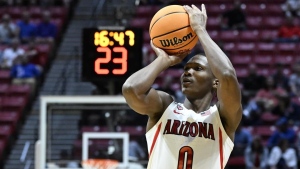Jun 23, 2022
Canadians Sharpe, Mathurin take different paths to NBA Draft
The two talented wings at the top of this year’s class arrived on team’s radars in completely different ways, Josh Lewenberg writes. Their unique journeys will converge Thursday night as they reach the cusp of their NBA dreams.

TORONTO – With draft night fast approaching, the best and brightest young basketball stars from around the globe are anxiously awaiting their fate.
Sixty of those players will hear their names called on June 23 at Barclays Center in Brooklyn. Thirty will be selected in the first round and sign guaranteed contracts worth seven or eight figures, life-changing money for teenagers starting their professional careers. In time, some of them might even blossom into NBA superstars.
But first they had to get to this point. Ask 10 draft prospects how they got here, and you’ll probably hear 10 different stories. That’s how it goes and what makes the process of becoming a pro athlete so intricate. There isn’t one right way to do it.
Case in point: the two talented Canadian wings at the top of this year’s class.
Expected lottery picks Shaedon Sharpe (London, Ont.) and Bennedict Mathurin (Montreal) could become the second Canadian duo to ever be selected inside of the top 10, and the first since Andrew Wiggins (first) and Nik Stauskas (eighth) in 2014.
There are some notable similarities between the two countrymen. They both look the part, with NBA-ready 6-foot-6 frames, long wingspans, and elite athleticism. They can both shoot the ball and possess the tools to defend at the next level. They’ve each represented and won a medal for Canada’s junior national teams.
That’s where the comparisons end. Their unique paths will converge Thursday night as they reach the cusp of their NBA dreams, but they’ve taken very different journeys to get there.
Sharpe wasn’t even on the radar of NBA clubs when he left home after his freshman year of high school less than three years ago.
At 15, he was cut by Team Ontario. His lone season playing high school basketball for H.B. Beal Secondary School in his hometown was promising, but he needed a bigger stage and a brighter spotlight to showcase his emerging set of skills.
As a late bloomer, those raw skills were there; they just needed to be refined.
“I think me and the other people that are part of his team knew he was going to be a top [ranked] kid pretty soon,” said David Sewell, who coached Sharpe at H.B. Beal in 2019 and has worked with him ever since. “We kinda figured it was going to happen sooner rather than later.”
“He made these flash plays; that’s how you knew he was gonna be really good,” said Patrick Tatham, an assistant coach with the Canadian team that won silver at the FIBA U16 Americas Championship in Brazil that summer. In his first taste of international competition, Sharpe averaged 13.0 points on an impressive 68 per cent shooting (79 per cent inside of the three-point arc).
“He had some of the best – not some of, the best dunks in training camp at that age group,” Tatham continued. “But he did it in flashes. You’d see him and he’d have this four-minute burst of just like dunk, dunk, three, steal and another dunk. And then he’d kinda just diminish. You wouldn’t even know that he’s on the court.”
 For his sophomore campaign, Sharpe moved south and enrolled at Sunrise Christian Academy, a private school in Kansas, but his development hit a snag. He was a 16-year-old living a long way from home, getting accustomed to new surroundings while playing for a team that was loaded at his position, so the dip in production wasn’t entirely unexpected or without justification. He barely played.
For his sophomore campaign, Sharpe moved south and enrolled at Sunrise Christian Academy, a private school in Kansas, but his development hit a snag. He was a 16-year-old living a long way from home, getting accustomed to new surroundings while playing for a team that was loaded at his position, so the dip in production wasn’t entirely unexpected or without justification. He barely played.
It wasn’t until his junior year, after transferring to Dream City Christian Academy in Arizona, that he really started to break out.
“His confidence skyrocketed in the 16 months he was with us,” Dream City head coach Kyle Weaver said. “You could just tell when he first got to us, leaving Sunrise and pretty much only playing three minutes a game [there], that he didn’t have the most confidence. But within about two months, he went from a three to about an eight or nine on the confidence scale.”
Weaver also credited Sharpe’s commitment to extending his range and improving his jump shot. At one point during the COVID shutdown, they were practising for five hours per day. Sharpe’s coming-out party was at the 2021 Nike Elite Youth Basketball League (EYBL), one of the top hoops circuits for players under the age of 18, where he led all scorers.
In just a few months, Sharpe went from being unranked to the consensus No. 1 recruit in his class – a meteoric and virtually unprecedented rise. Suddenly, he was on everybody’s radar.
“I don’t think I’ll ever see that again, a kid jumping the ranking that much, that quickly,” said Weaver, who’s also worked with Phoenix Suns centre and former first-overall pick Deandre Ayton.
“When you’re the No. 1 guy on ESPN and you’re the leading scorer at the EYBL, with all those tools, they really label you as next,” said Wes Brown, a Canadian basketball scout. “So, the work was done at that point.”
Sharpe hasn’t played a competitive game of basketball since the EYBL nearly a year ago. Although he committed to play college hoops at Kentucky last fall, he never ended up logging a single minute for John Calipari and the Wildcats.
Initially, the stated plan was for the 18-year-old to join them on campus ahead of the second semester and participate in practices with his new team, but he would sit out the rest of the campaign and prepare to begin his college career at the start of next season, with the hopes of going pro in 2023.
At some point, plans changed. Sharpe was ruled eligible for the 2022 draft because he graduated high school prior to the start of the 2021-22 NBA season and would turn 19 in May, before the end of the calendar year.
With his stock continuing to skyrocket, Sharpe and his representatives – led by his advisor, head coach and founder of UPLAY Canada Dwayne Washington – made the obvious decision to declare for the draft.
Were they ever intending to return to school for next season or was this always the plan? It depends on who you ask. According to one league scout, the suspicion is that they knowingly “duped” Kentucky. Regardless, if you’re all but guaranteed a top-10 slot in the NBA draft – perhaps even top five – and an annual salary north of $5 million to begin your pro career without having to risk injury, why wouldn’t you take it?
“This ended up being his situation and it’s just worked out,” said Sewell. “Did he know that he was going to be considered a top-eight guy when he first went to Kentucky? I don’t think he did know that. With that being said, everybody’s got a different story and he’s writing his own.”
Mathurin took a different approach in the years leading up to this draft. He’s prioritized getting reps at every level; the chance to not only grow and expand his game, but to show NBA teams just how much he’s improved.
Like Sharpe, Mathurin is a quiet, unassuming young man. The 19-year-old, who turns 20 four days before the draft, enjoys watching movies, playing video games, and hanging out with close friends and family. But mostly, you can find him on the court working on his craft. Unlike Sharpe, his confidence has never been in doubt. He’s had it in spades since he was a kid, growing up in the rough neighbourhood of Montreal-Nord.
“He was 10, competing against guys who were 15, 16, 17 and thinking he was the best player on the court,” said Nelson Osse, director of the PX Knights youth basketball program in Quebec, who has known and worked with Mathurin for more than a decade. “Regardless of who he was playing, he always thought he was that guy.”
As a high schooler, Mathurin was considered a four-star college recruit and wasn’t garnering much attention south of the border. Instead of enrolling at a U.S.-based prep school, a popular route for Canadian prospects, he decided to roll the dice and take a more unique path.
At 16, Mathurin moved to Mexico and joined the NBA Academy Latin America – an elite basketball training program for high school prospects outside of the U.S. The program, one of four around the world, provides its student athletes with a holistic approach to their on- and off-court development. Mathurin was its first ever Canadian recruit.
“Him and his family made a decision where they thought that was the best path for him. But not only that, Benn saw it as a challenge,” said Osse. “It was a challenge for him but Benn loves challenges. One thing people shouldn’t tell Benn is what he can’t do.”
 In 2020, Mathurin committed to play college basketball at Arizona, where he averaged 10.8 points and 4.8 rebounds during a solid freshman campaign. He started 12 of his 26 games and impressed as a shooter, hitting 42 per cent of his 91 three-point attempts.
In 2020, Mathurin committed to play college basketball at Arizona, where he averaged 10.8 points and 4.8 rebounds during a solid freshman campaign. He started 12 of his 26 games and impressed as a shooter, hitting 42 per cent of his 91 three-point attempts.
The Montreal native had shown enough to earn his way onto an NBA roster, if not through the 2021 draft – where he could have been a late first-round or second-round pick, had he declared – then certainly as an undrafted free agent.
But Mathurin felt like he had unfinished business. So, with his decision to return to Arizona for a sophomore season, he bet on himself.
“I know he was getting a lot of calls from people who thought he should leave after his freshman year, but I think from the get-go Benn was just not satisfied,” Osse said. “He really felt like people were not mentioning him last year as a potential lottery pick and his goal was to come back and be that guy, be the first lottery pick out of Quebec and Montreal.”
Last summer was a busy one for Mathurin. He was in training camp with the Canadian senior national team ahead of their last-chance Olympic qualifying tournament before travelling to Latvia for the FIBA U19 World Cup, where he helped lead the junior club to a bronze-medal finish.
“Benn’s been doing it for a while,” said Tatham, an assistant with that U19 team and one of the few people who have coached both Mathurin and Sharpe over the years. “But once he figured it out, he really exploded and it really showed that, yeah, this guy’s the real deal.”
When he was back home, Mathurin spent the off-season training with Oklahoma City Thunder guard Luguentz Dort, a fellow Montrealer who also grew up playing for Osse’s youth teams. Widely regarded as one of the best and toughest perimeter defenders in the NBA, Dort’s impact on the younger Mathurin can’t be understated. You could see it throughout his sophomore campaign, as he took a big step forward on the defensive end of the floor.
“It’s like a big brother relationship,” Osse said. “Benn looked up to Lu. They’re from the same neighbourhood in Montreal, where usually all you hear [about] is the bad things coming out with violence and gangs and stuff. But with these two making it, it’s a good story for younger kids in Montreal like them that weren’t supposed to make it.”
Mathurin started all 37 games he played this past season. He averaged 17.7 points and 5.6 rebounds, shot 37 per cent on a higher volume of threes, and led the Wildcats to a No. 1 seed while earning Pac-12 Player of the Year honours.
Mission accomplished. While Dort and Toronto Raptors’ big men Chris Boucher and Khem Birch have made names for themselves in the NBA despite going undrafted, Mathurin is poised to become the first Montreal native to be selected inside of the lottery later this month. Most scouts believe he’ll be a top-10 pick.
By this point, the team that calls his name on draft night should have a pretty good idea of what they’re getting in the soon-to-be 20-year-old. There’s no shortage of game tape available on Mathurin, which can be both a blessing and a curse. NBA front offices have seen enough to know what he can do, giving them a certain level of comfort if they’re looking at drafting him, but they’re also familiar with what he can’t do – the holes in his game or the areas in which he still needs to improve.
Sharpe’s case is the complete opposite.
Scouting is an inexact science. You do your due diligence and learn everything you can about the player, but at the end of the day there’s always going to be some level of weighing risk versus reward, and then hoping for the best.
With Sharpe, the potential reward is massive, which explains the intrigue. He’s an incredibly skilled player with elite physical tools, a nearly seven-foot wingspan and above-the-rim athleticism.
In what’s considered to be a weaker class, without a consensus first-overall pick, there’s a conceivable scenario in which Sharpe ends up being this draft’s best player down the line. And because he hasn’t faced live, high-level competition in a year, you can probably get him outside the top three.
The Sacramento Kings, who own the fourth-overall pick, and the Detroit Pistons, who select fifth, are among the teams that have expressed interest in Sharpe, according to sources. Given where they are in their respective rebuilds, you can understand why.
If he hits, Sharpe would look pretty good manning the wing next to last year’s top pick Cade Cunningham in Detroit, or satisfy pressure from within the Kings organization to find a star through the draft and finally snap their league record 16-year playoff drought.
But considering no one has seen Sharpe outside of a practice or individual workout setting in months, the risk is inherently higher. Naturally, inquiring teams have a lot of questions.
Weaver, Sharpe’s high school coach at Dream City, says he’s heard from five of the clubs selecting in the top seven, with three or four of them calling almost every week to check in. They’re looking for any kind of reassurance they can find to feel comfortable with Sharpe and his rapid ascension, despite the small sample size and concerns about his motor running hot and cold.
“To be honest, there are international kids that have been taken higher with less,” Weaver said. “So, I think [teams] are just trying figure out [who he is] because he hasn’t played lately… I think there is a risk; everybody’s gonna say there’s a risk and I’m not gonna lie about it, but the reward is so much greater. It’s a no-brainer to me.”
“I feel like I’ve seen a little more maybe because I’ve had the chance to work with him for so long,” said Sewell. “But I think the people who aren’t sure, the people who think he’s a mystery, will be surprised by how skilled he is.”
Of the two, Mathurin might be perceived as the safer pick, but teams would be wise not to confuse safe with boring. While he’s a year older than Sharpe, and certainly less mysterious, there’s upside to be found here too.
He hasn’t just played in high-pressure, high-leverage situations; he’s thrived in those big moments. Mathurin had 31 points in the bronze-medal game for the U19 Canadian team last summer. He also scored 30 in Arizona’s second-round win over TCU during the NCAA tournament this past spring.
Sharpe will likely hear his name called ahead of Mathurin, because upside usually wins out on draft night, especially towards the top of the lottery. However, many of the folks who have followed the rise of both Canadians believe that Mathurin just might be the better pro out of the gate, and perhaps in the long run as well.
“I think Mathurin is well-liked and he has such a high floor because, unlike Sharpe, we’ve seen him,” Brown said. “I have no doubt that Mathurin can be an NBA starter. Will he be a star? Maybe, I don’t know. But do we feel pretty good about his floor, about his competitiveness as a person, about his ability to make shots and his ability to defend? I feel very comfortable. He really has gotten a lot better each year… So, I think he’s a really safe pick. And Sharpe may be the opposite, but Sharpe’s athletic floor is very high, so he should be okay.”


